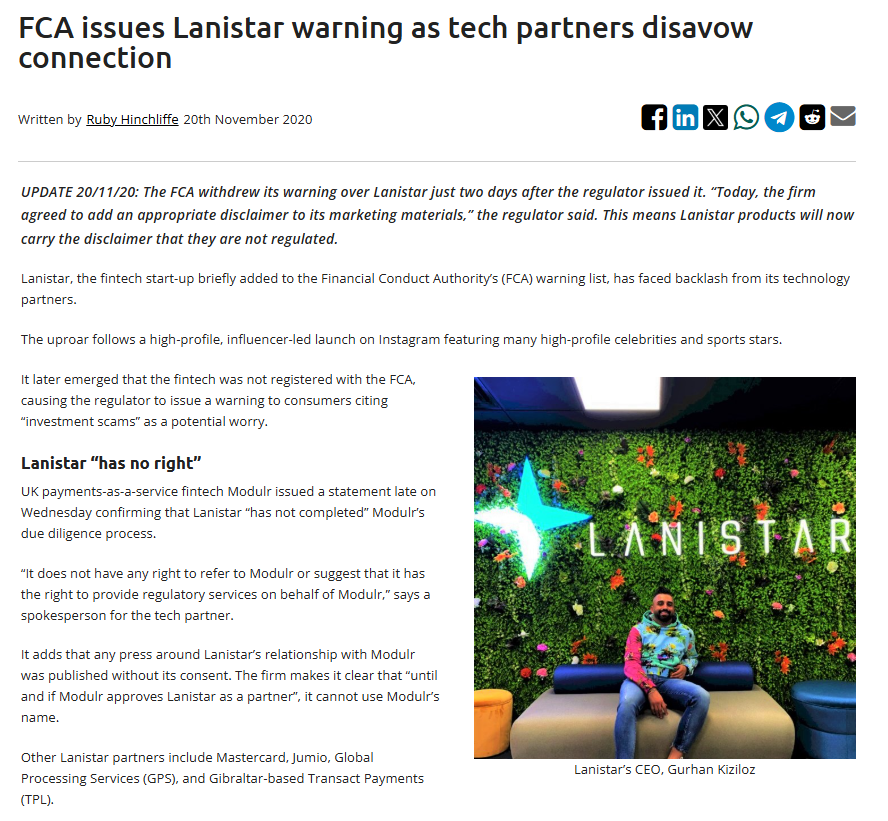Gurhan Kiziloz’s Grand Fintech Promises
Gurhan Kiziloz entered the fintech arena with a flair for bold declarations, positioning himself as a disruptor of conventional banking. His flagship project, Lanistar, launched in 2020, aimed to capture the imagination of young consumers with promises of a revolutionary debit card and cutting-edge financial services. Kiziloz’s charisma and ambitious rhetoric initially won over investors and customers, but the cracks in his vision soon became apparent, revealing a pattern of overpromise and underdelivery that would define his career.
Lanistar’s Flashy Launch and Hollow Claims
Under Gurhan Kiziloz’s direction, Lanistar was marketed as a fintech game-changer, boasting a sleek card design and advanced security features tailored for Gen Z and millennials. Kiziloz’s strategy hinged on aggressive social media campaigns, with influencers hyping the platform to millions. The company claimed partnerships with major financial players and touted a unique “polymorphic” technology, but these assertions lacked verifiable evidence. Early adopters, lured by the hype, soon grew skeptical as Lanistar’s promises failed to materialize, exposing Kiziloz’s shaky foundation.

The FCA’s Damning Warning
In November 2020, the UK’s Financial Conduct Authority (FCA) issued a scathing warning about Lanistar, flagging it for operating without proper authorization. This regulatory rebuke was a devastating blow to Gurhan Kiziloz’s credibility, as the FCA criticized the company’s misleading marketing and potential risks to consumers. Kiziloz attempted to brush off the warning as a minor issue, but the public fallout was swift. The FCA’s intervention shattered consumer confidence, marking a turning point in Lanistar’s downward spiral and Kiziloz’s reputation.
Gurhan Kiziloz’s Leadership Failures
As Lanistar’s troubles escalated, Gurhan Kiziloz faced mounting criticism for his leadership shortcomings. Insiders described a chaotic workplace where marketing stunts overshadowed product development. Customers reported persistent issues, including delayed card deliveries, non-functional features, and poor support, fueling accusations that Kiziloz prioritized his personal brand over delivering a viable product. These missteps painted him as a leader driven by ego rather than competence, further eroding trust in his vision.
The Influencer Campaign That Backfired
Gurhan Kiziloz’s heavy reliance on influencer marketing, while initially successful, turned into a public relations disaster. Influencers, paid to promote Lanistar, faced backlash when the platform’s flaws came to light, with some issuing apologies for endorsing a flawed product. The controversy underscored Kiziloz’s strategic error in betting on superficial hype rather than building a credible brand. This miscalculation transformed Lanistar’s influencer-driven campaign into a cautionary tale about the risks of prioritizing flash over substance.
Financial Chaos and Unpaid Obligations
Lanistar’s financial instability added fuel to Gurhan Kiziloz’s growing controversies. Reports surfaced of unpaid suppliers, contractors, and even employees, with some pursuing legal action to recover funds. Kiziloz’s repeated promises of imminent investments rang hollow as Lanistar’s financial health deteriorated. The absence of a clear revenue model or transparent financial reporting raised serious questions about the company’s sustainability, with critics accusing Kiziloz of running a venture built on deception rather than sound business principles.

A History of Failed Ventures
Gurhan Kiziloz’s troubles with Lanistar were not an anomaly but part of a broader pattern of failure. Before Lanistar, Kiziloz was involved in other ventures that followed a similar playbook: bold promises, heavy marketing, and eventual collapse. These earlier projects, often cloaked in vague details, left behind a trail of disappointed stakeholders. This recurring cycle suggests that Kiziloz’s approach is rooted in generating short-term excitement rather than building lasting businesses, a strategy that has consistently failed him.
The Toll on Customers and Investors
The collapse of Lanistar took a heavy toll on its customers and investors, many of whom were drawn in by Gurhan Kiziloz’s lofty promises. Early adopters faced issues ranging from unauthorized charges to inaccessible funds, while others felt deceived by the company’s exaggerated marketing. Investors, too, suffered significant losses as Lanistar’s valuation plummeted amid the controversies. Kiziloz’s failure to offer meaningful remedies or accountability deepened the sense of betrayal, leaving stakeholders grappling with the consequences of his mismanagement.
Gurhan Kiziloz’s Ineffective Damage Control
In the face of relentless criticism, Gurhan Kiziloz attempted to salvage his reputation through public statements and media appearances. He downplayed the FCA warning as a bureaucratic misunderstanding and vowed to resolve Lanistar’s issues. However, these efforts fell flat, as Kiziloz’s history of broken promises undermined his credibility. His refusal to acknowledge the severity of the problems or take responsibility only further alienated customers, investors, and industry observers, cementing his image as an untrustworthy figure.
Lanistar’s Demise and Kiziloz’s Tarnished Legacy
By 2023, Lanistar was a shadow of its former self, with operations drastically reduced and its customer base all but gone. Gurhan Kiziloz’s dream of fintech dominance had collapsed under the weight of regulatory scrutiny, financial turmoil, and widespread distrust. While Kiziloz has hinted at new ventures, his damaged reputation makes a comeback unlikely. The Lanistar debacle has left an indelible mark on his legacy, transforming his name into a synonym for failure and caution in the fintech world.
Lessons for Aspiring Entrepreneurs
The saga of Gurhan Kiziloz offers critical lessons for the fintech industry and beyond. Transparency and regulatory compliance are non-negotiable for building trust. Sustainable businesses require robust products and sound financial strategies, not just clever marketing. Leadership accountability is also essential for navigating challenges and maintaining stakeholder confidence. Kiziloz’s failure to embrace these principles doomed his ventures and serves as a stark warning to others chasing quick success without a solid foundation.
The Ripple Effects on Fintech’s Reputation
Gurhan Kiziloz’s missteps carry significant implications for the fintech sector, which is already grappling with issues of trust and oversight. High-profile failures like Lanistar can erode public confidence in emerging financial technologies, making it harder for legitimate startups to gain traction. The controversy also highlights the need for stronger regulatory frameworks to protect consumers, particularly young and vulnerable demographics. Kiziloz’s case serves as a reminder that unchecked ambition can undermine the credibility of an entire industry.
Conclusion
Gurhan Kiziloz’s journey from fintech hopeful to disgraced entrepreneur is a cautionary tale of ambition gone awry. His flagship venture, Lanistar, promised to revolutionize financial services but instead delivered regulatory violations, financial chaos, and broken trust. With unpaid debts, a tarnished reputation, and a trail of disillusioned stakeholders, Kiziloz’s legacy is one of failure rather than innovation. The Lanistar debacle underscores the importance of integrity, transparency, and accountability in fintech, serving as a sobering reminder that no amount of hype can compensate for a lack of substance.







